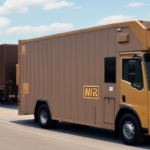Understanding UPS Shipping Rates and Maximizing Value
For businesses that regularly ship products to customers, comprehending UPS shipping rates is crucial to optimizing costs and ensuring profitability. Whether shipping domestically or internationally, various factors influence shipping expenses. Gaining insight into these factors and understanding how UPS calculates shipping rates enables businesses to make informed decisions about their shipping strategies.
The Key Factors Influencing UPS Shipping Rates
Before delving into the specifics of UPS shipping rates, it's essential to recognize the different elements that can impact your shipping costs:
- Distance and Destination: The origin and final destination of your shipment play a significant role in determining costs.
- Weight and Dimensions: Heavier and larger packages typically incur higher shipping fees.
- Service Type: The selected UPS service level, such as ground or expedited shipping, affects pricing.
- Declared Value: The value declared for your shipment can influence shipping costs, especially for insurance purposes.
- Shipping Speed: Faster delivery options generally come at a premium cost.
Understanding and strategically managing these factors can lead to substantial savings on your shipping expenses.
Seasonal Variations in UPS Shipping Rates
Shipping rates can fluctuate based on the time of year. During peak seasons like the holidays, increased demand may drive up shipping costs. To mitigate these spikes, consider:
- Planning shipments well in advance.
- Opting for alternative shipping methods during high-demand periods.
- Leveraging UPS's seasonal discounts and promotions.
Proactive planning helps avoid unexpected increases in shipping expenses during critical business periods.
Impact of Item Type on Shipping Costs
The nature of the items being shipped also affects shipping rates. Items classified as hazardous or those requiring special handling may incur additional fees. To prevent unforeseen charges:
- Proper Labeling: Ensure all packages are accurately labeled according to UPS guidelines.
- Secure Packaging: Use appropriate packaging materials to comply with UPS standards and avoid damage during transit.
Distance and Destination: A Closer Look
The distance your package travels is a primary determinant of shipping costs. Generally, longer distances result in higher fees. Additionally, shipments to remote or difficult-to-access locations may attract extra charges. For businesses frequently shipping to diverse regions, partnering with UPS to identify the most cost-effective shipping routes and services is advisable.
Moreover, accurately measuring and weighing packages can prevent unexpected costs associated with oversized or overweight shipments. Utilizing lightweight yet protective packaging materials can also contribute to cost reduction.
Package Weight and Dimensions: Cost Implications
The size and weight of your packages significantly influence shipping rates. UPS accounts for these factors as they affect the fuel consumption and resources required for transportation. To optimize costs:
- Optimize Packaging: Reduce package size and weight without compromising the safety of the contents.
- Understand Carrier Restrictions: Different carriers have varying weight and size limitations. For example, [USPS](https://www.usps.com) sets a maximum weight limit of 70 pounds for Priority Mail packages and a combined length and girth limit of 108 inches.
Staying informed about carrier-specific guidelines helps avoid additional fees and shipping delays.
UPS Shipping Zones and Their Cost Impact
UPS shipping rates are categorized by shipping zones, which are determined by the distance between the shipment's origin and destination. The United States is divided into nine UPS shipping zones, with Zone 1 being the closest and Zone 9 the farthest. Shipping within the same zone typically incurs lower costs compared to cross-zone shipments.
For instance, shipping a package from New York City to Boston (both in Zone 2) will be more economical than shipping from New York City to Los Angeles (Zone 8). Businesses shipping frequently across various zones should collaborate with UPS to identify the most cost-effective shipping options tailored to their needs.
Choosing the Right UPS Service: Types and Costs
UPS offers a diverse range of shipping services to accommodate businesses of all sizes. These services vary in speed, cost, and specific features:
- Next Day Air: Guarantees delivery by the next business day, ideal for urgent shipments but at a higher cost.
- 2nd Day Air: Ensures delivery within two business days, offering a balance between speed and cost.
- Ground Shipping: A cost-effective option for less time-sensitive shipments.
Additionally, UPS provides value-added services such as package tracking, insurance, and signature confirmation. These services enhance security and provide peace of mind but may come with extra fees. Evaluating the necessity of these services against their costs is essential for budgeting.
Selecting the Optimal UPS Service for Your Business
Choosing the appropriate UPS service involves balancing delivery speed, cost, and the specific needs of your business. Consider the following when selecting a service:
- Urgency: Determine how quickly the shipment needs to arrive.
- Budget: Assess your budget constraints and choose a service that offers the best value.
- Reliability: Opt for services with a strong track record of on-time deliveries to ensure customer satisfaction.
Consulting with a UPS representative can provide personalized guidance, helping you navigate the available options and select the most suitable service for your business requirements.
Calculating Estimated UPS Shipping Costs
To estimate your shipping costs accurately, utilize UPS's online shipping calculator. By inputting factors such as package size, weight, destination, and desired shipping speed, you can obtain a comprehensive cost estimate. This tool aids in budgeting and comparing different shipping options to identify the most cost-effective solution for your needs.
Negotiating Better Shipping Rates with UPS
Businesses with high shipping volumes may have the opportunity to negotiate more favorable rates with UPS. Factors that can enhance your negotiating position include:
- Shipping Volume: Higher volumes can leverage discounts.
- Long-Term Agreements: Committing to long-term shipping contracts may secure better rates.
- Consistent Shipping Patterns: Demonstrating consistent shipping behavior can make negotiations smoother.
Engaging with a UPS representative to discuss your shipping patterns and requirements can lead to customized rate agreements that significantly reduce your shipping expenses.
Leveraging UPS's Online Tools for Cost Savings
UPS provides a suite of online tools designed to help businesses minimize shipping costs, including:
- Shipping Calculators: Estimate costs and compare different shipping services.
- Discounts on Labels and Packaging: Save on essential shipping materials.
- Tracking and Analytics: Monitor shipments and analyze shipping data to optimize routes and reduce inefficiencies.
Utilizing these tools effectively can lead to substantial savings and more streamlined shipping operations.
Best Practices for Packaging and Labeling
Proper packaging and labeling are critical to avoiding additional fees and ensuring the safe delivery of your shipments. Follow these best practices:
- Accurate Labeling: Ensure all shipping information is correct and clearly visible.
- Secure Packaging: Use appropriate materials to protect items during transit and prevent damage.
- Compliance: Adhere to UPS packaging guidelines to avoid delays and extra charges.
Implementing these practices not only reduces the risk of incurring additional fees but also enhances customer satisfaction by ensuring timely and intact deliveries.
Avoiding Common Mistakes That Increase Shipping Costs
Several common errors can lead to higher UPS shipping rates, including:
- Incorrect Service Selection: Choosing an inappropriate shipping service level can result in unnecessary expenses.
- Poor Labeling: Mislabeling packages may lead to delivery delays and additional fees.
- Overpacking: Excessive packaging can increase weight and dimensions, raising shipping costs.
By being aware of these pitfalls and implementing strategies to avoid them, businesses can maintain control over their shipping expenses and ensure efficient operations.
The Role of Insurance in Shipping
Shipping insurance plays a pivotal role in protecting your shipments against loss, theft, or damage. While it adds to the initial shipping cost, insurance can prevent significant financial losses and disputes:
- Risk Mitigation: Insuring high-value items safeguards your investment.
- Customer Assurance: Offering insured shipments can enhance customer trust and satisfaction.
- Cost Management: In the event of an incident, insurance coverage can minimize out-of-pocket expenses.
When selecting UPS shipping options, consider the value of your shipments and the potential risks involved to determine the appropriate level of insurance coverage.
The Importance of Shipment Tracking
Tracking shipments is essential for both businesses and customers. It offers several benefits, including:
- Visibility: Real-time tracking provides updates on the shipment's status and location.
- Issue Identification: Early detection of delays or problems allows for timely interventions.
- Customer Communication: Providing tracking information enhances transparency and customer satisfaction.
Effective tracking can lead to cost savings by identifying inefficiencies in shipping routes and enabling adjustments to optimize delivery times and expenses.
Conclusion
Understanding UPS shipping rates and strategies to maximize value is essential for businesses reliant on shipping products to customers. By considering factors such as shipping zones, package dimensions, service types, and leveraging UPS's online tools and resources, businesses can make informed decisions that optimize shipping costs. Additionally, implementing best practices in packaging, labeling, and tracking ensures efficient operations and enhances customer satisfaction. Collaborating with UPS representatives to negotiate better rates and utilizing shipping insurance further contribute to cost-effective and secure shipping processes. Adopting these strategies enables businesses to achieve the best value for their shipping investments, fostering growth and sustainability.




















